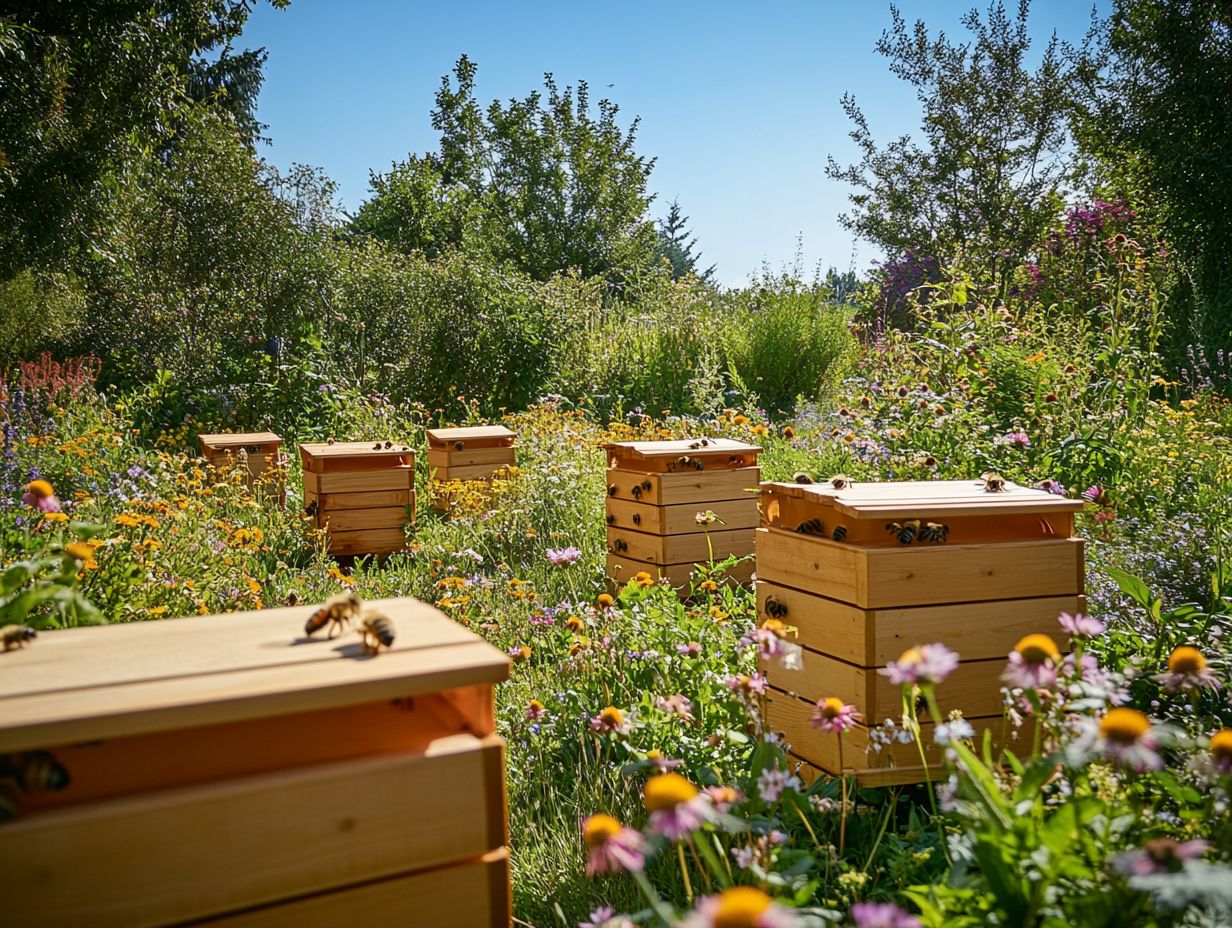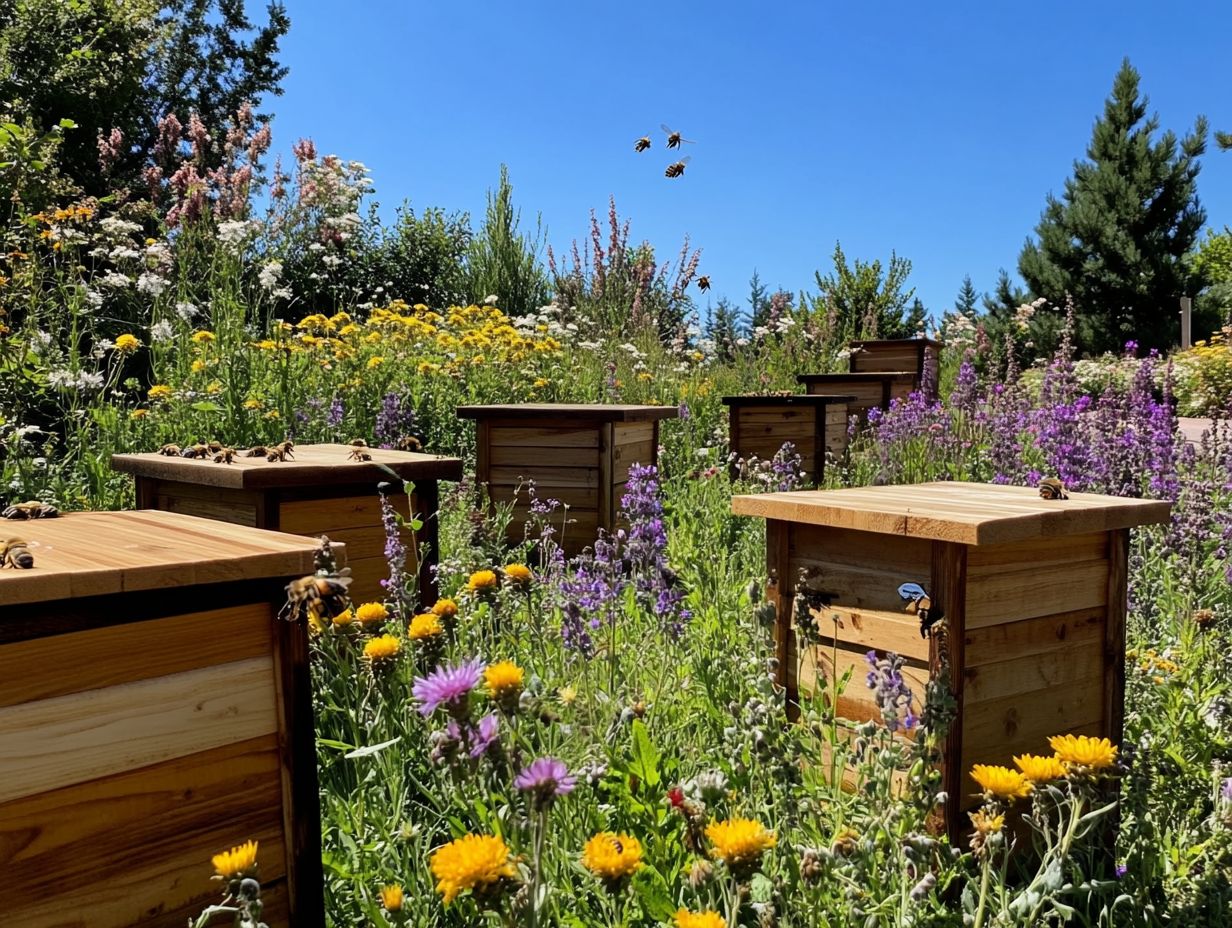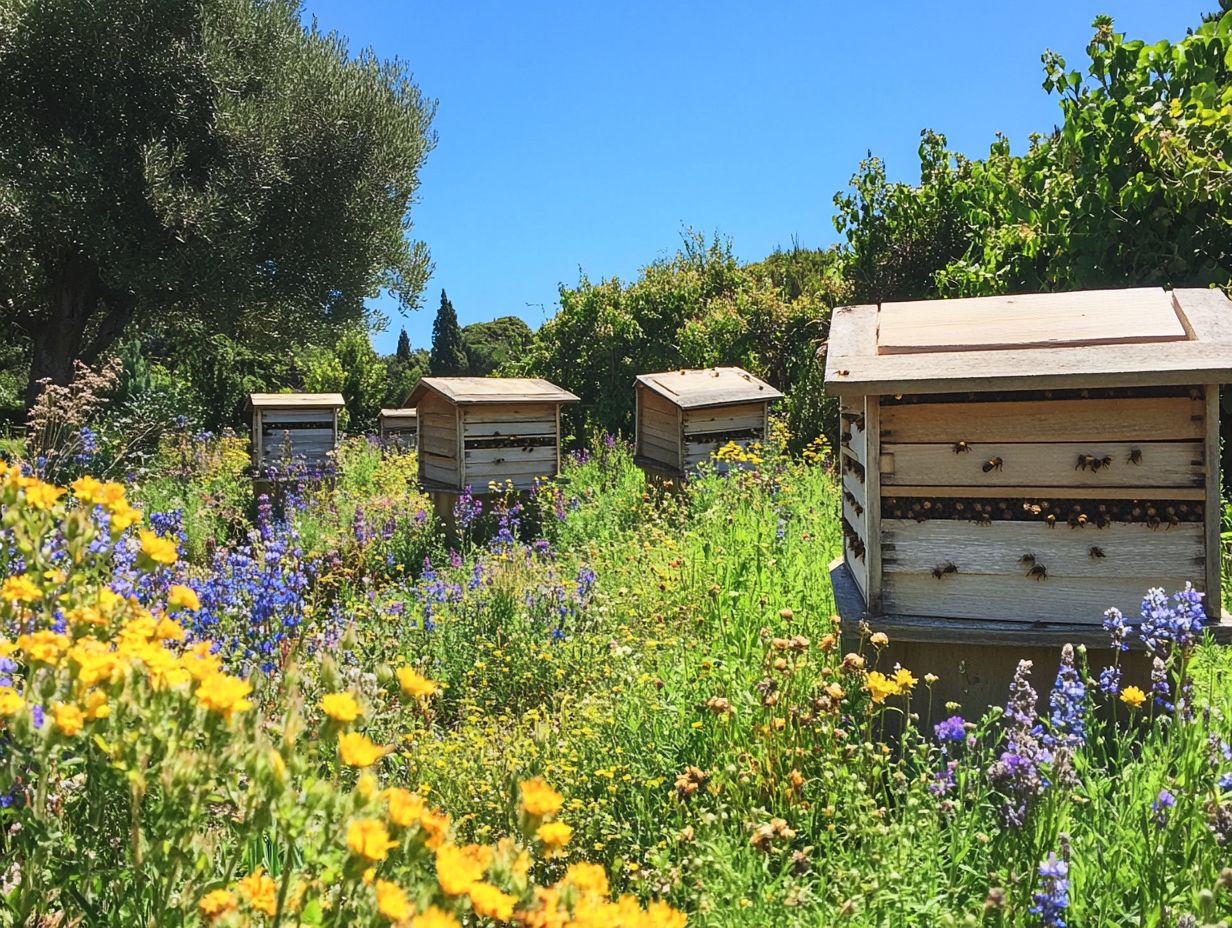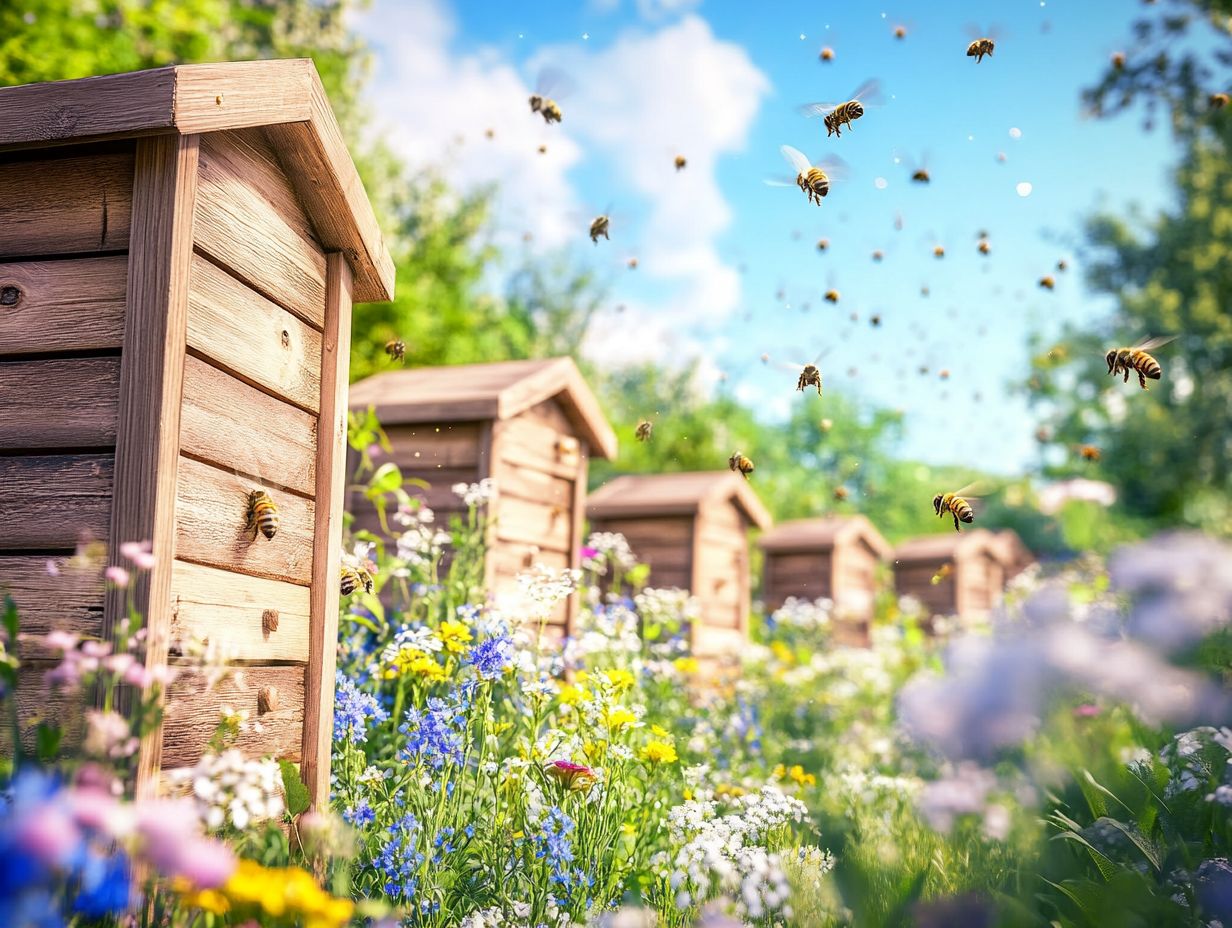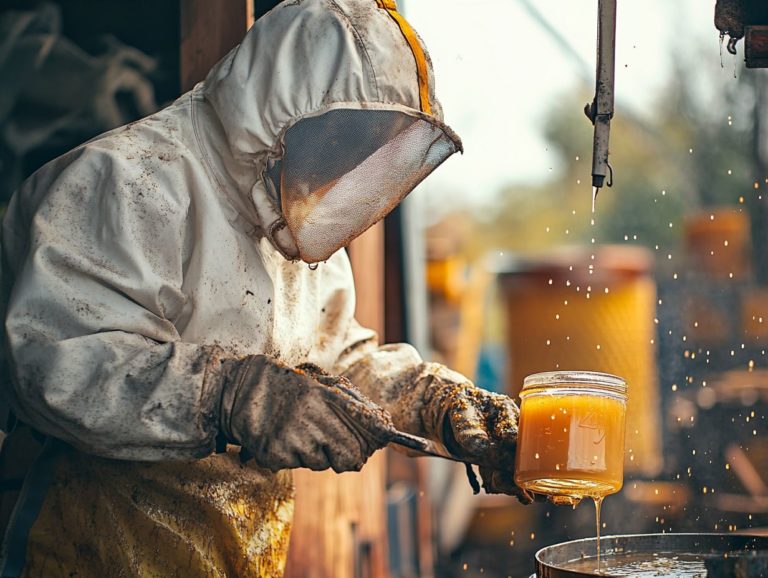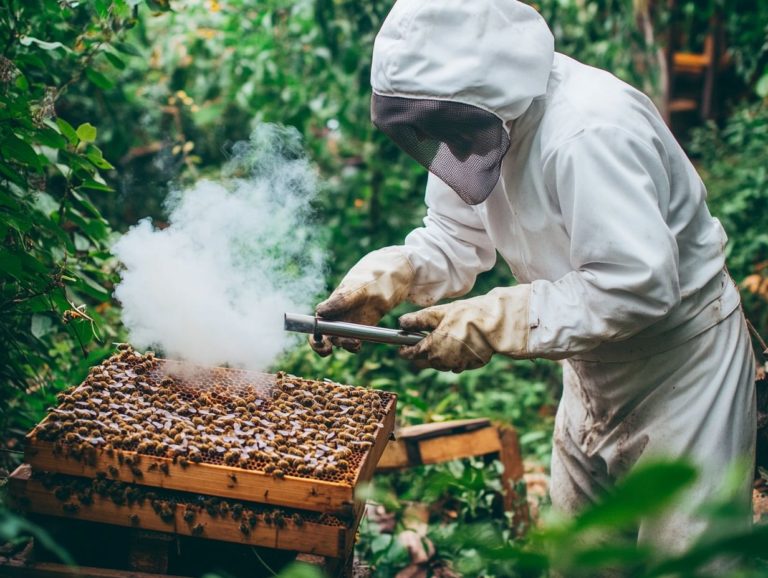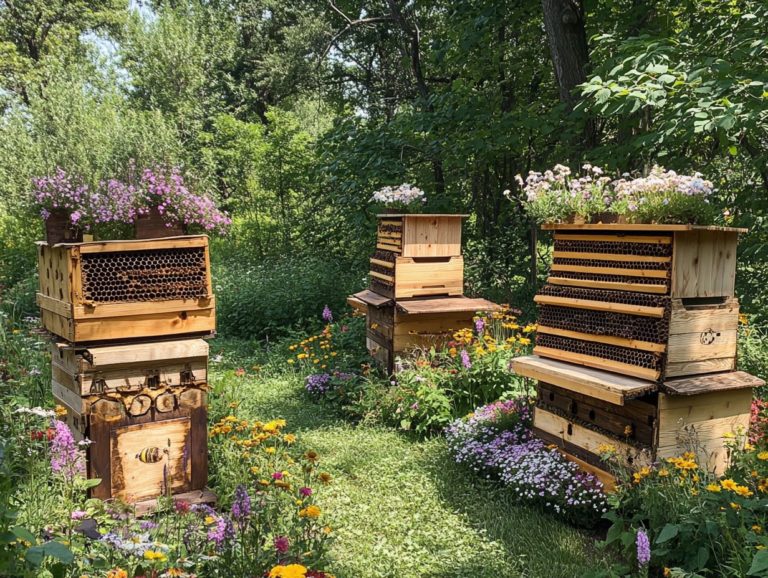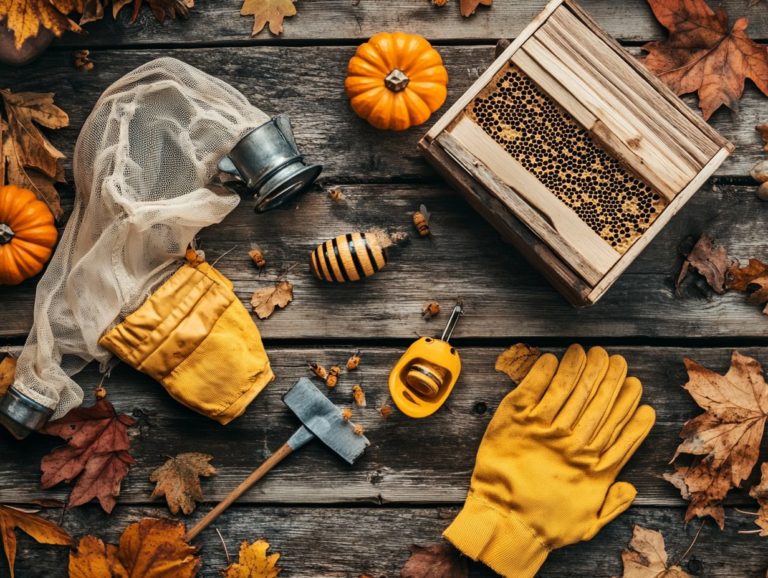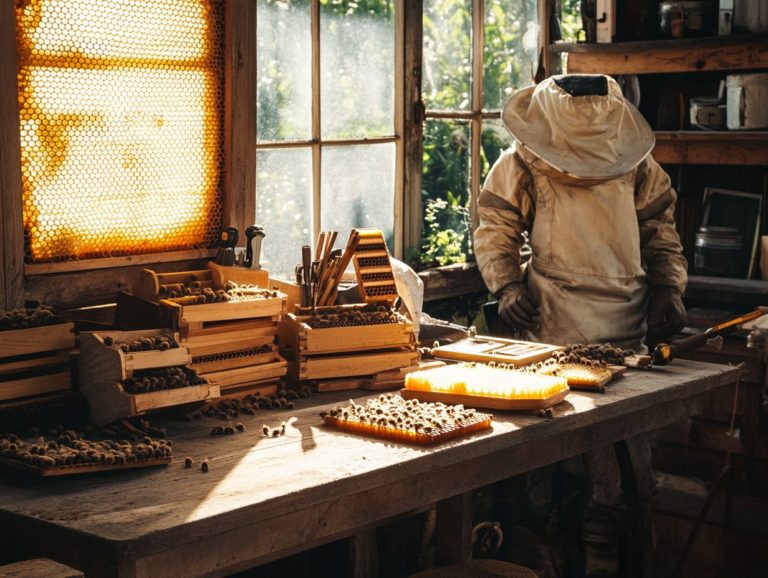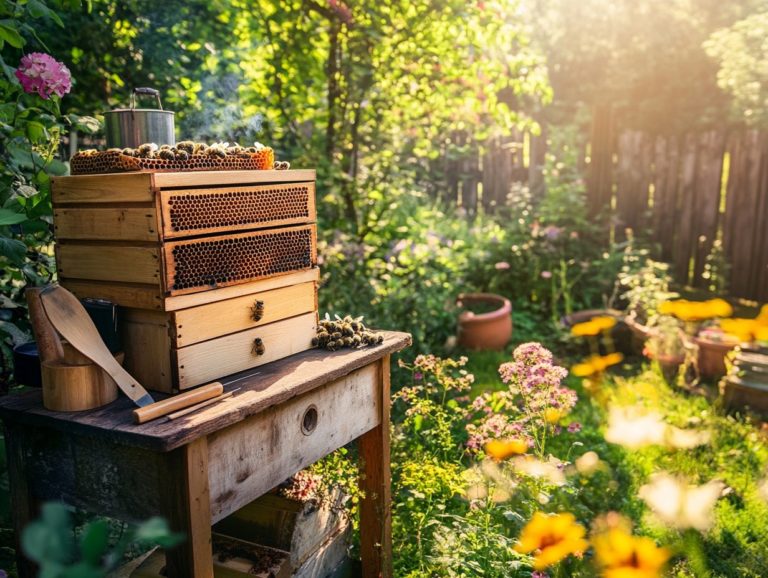The Advantages of Using Wooden Hives
Wooden hives have emerged as a favored option among beekeepers, seamlessly combining functionality with natural beauty.
This article delves into the essence of wooden hives and explores the reasons behind their surge in popularity. Get ready to explore the exciting types of wooden hives available, such as Langstroth and Top-bar hives, and learn about the substantial benefits they offer for both bee health and maintenance costs.
You’ll also find essential tips for maintaining wooden hives to ensure your bee community thrives. Immerse yourself in this exploration to discover why wooden hives could be the ideal choice for your beekeeping journey.
Contents
Key Takeaways:
- Wooden hives offer natural insulation, durability, and breathability, making them a superior choice for beekeeping.
- Different types of wooden hives, including Langstroth, Top-bar, Warre, and Horizontal hives, provide options for various practices.
- Wooden hives benefit bee health, are cost-effective, sustainable, and visually appealing.
What are Wooden Hives?
Wooden hives are essential structures that beekeepers rely on to nurture their colonies. They also streamline honey production.
Their popularity comes from their natural materials, which offer insulation, durability, and a comfortable environment for the bees.
As the beekeeping community expands, the demand for these wooden hives shows no signs of waning, appealing to both newcomers and seasoned beekeepers alike. The allure of wooden hives is not just about their charming appearance; it’s also about their remarkable functionality that fosters a thriving bee population and supports efficient honey production.
Why Use Wooden Hives?
Wooden hives bring numerous advantages for beekeepers. You’ll enjoy natural insulation, exceptional durability, and a charming aesthetic that beautifully complements the setting of your apiary.
Many beekeepers prefer wooden hives for their timeless appeal and customization options, allowing you to personalize both design and functionality.
Choosing wooden hives supports eco-friendly practices since they are often made from renewable resources, minimizing the detrimental impacts that synthetic materials can impose on the environment.
1. Natural Insulation
Wooden hives provide remarkable natural insulation. This helps maintain a stable temperature for your bees throughout the seasons.
This insulation is vital for the health and productivity of your bee colony, especially in colder months when warmth is essential for hive survival.
Wood regulates temperature effectively, often leading to increased honey production. In contrast, while polystyrene and plastic frames may be lightweight and easy to handle, they lack the same level of thermal stability.
By choosing wooden hives, you support sustainable practices and create a healthier ecosystem for your colonies.
2. Durable and Long-lasting
Wooden hives are celebrated for their durability and long-lasting performance. They are an astute choice for any beekeeper. Unlike synthetic materials that may succumb to degradation over time, wooden hives are built to endure the elements and the passage of time, as long as they receive the necessary maintenance.
Regular treatments with protective oils and stains not only preserve the integrity of wooden hives but also ensure they remain steadfast through the seasons. This dedication to upkeep prolongs their lifespan and fortifies their defenses against pests and moisture.
While polystyrene boxes might initially attract you with their lightweight design and insulation properties, they often struggle with issues like brittleness and an inability to be repaired over time. Their shorter lifespan can lead to frequent replacements, making wooden hives a more cost-effective and reliable choice for beekeepers seeking enduring performance and longevity in their apiaries.
3. Ventilated Material
The ventilated design of wooden hives provides essential ventilation, which is crucial for maintaining a healthy hive environment. This feature helps regulate humidity levels and encourages bees to build the honeycomb structure efficiently, promoting the overall health of the colony.
A well-ventilated hive cultivates a stable microclimate that supports the bees’ natural behaviors and enhances honey production. Relying on polystyrene or plastic frames can trap heat and moisture, potentially leading to mold growth and stress within the colony.
A compromised environment can hinder the bees’ activities, diminishing their ability to thrive and ultimately impacting the quality and quantity of honey they produce. By choosing wooden hives, beekeepers create a more favorable living space for their bees and position themselves to enjoy the benefits of healthier colonies and abundant harvests.
4. Easy to Customize
Wooden hives offer exceptional customization options. You can tailor your hives to meet specific needs and preferences. Select the type of wood and design hive bodies that cater to the particular species of bees you work with. This flexibility significantly enhances the beekeeping experience.
Your customization choices can encompass various sizes, such as deep or shallow hive bodies, aligning perfectly with your honey production goals and the climate you’re navigating. Explore extensive design variations, like layout configurations that promote better airflow or minimize moisture buildup.
Don’t miss out on essential modifications—adding insulation or incorporating observation windows can greatly improve functionality and make monitoring bee activity a breeze. Beekeeping suppliers provide the necessary materials and expertise to support your customization efforts, ensuring that operations can scale efficiently while optimizing the health and productivity of your bees.
What Types of Wooden Hives are Available?
You’ll find an impressive array of wooden hives on the market, each thoughtfully designed to meet the unique needs of beekeepers. Whether drawn to the classic Langstroth hives, the innovative Top-bar hives, the rustic Warre hives, or the efficient Horizontal hives, each type offers its distinct advantages and features.
This diversity allows you to choose a hive that perfectly aligns with your beekeeping style and objectives.
1. Langstroth Hives
Langstroth hives stand out as the most popular choice among beekeepers. Their efficient design and user-friendly approach make honey production simple and effective.
These hives consist of stacked boxes with removable frames, granting you easy access to manage your bees. This structure allows you to inspect and maintain the colony without disturbing the entire hive.
With removable frames, you can customize your setup to meet your colonies’ specific needs. This fosters a more hygienic environment that minimizes the risk of disease outbreaks.
The deep frames in Langstroth hives provide ample space for bees to store honey and bee babies, leading to increased honey yields. The flexible design lets you add super boxes during peak production times, optimizing performance.
2. Top-bar Hives
Top-bar hives present an innovative alternative to traditional designs. They allow bees to build their comb naturally, free from the constraints of frames.
This design supports a more natural approach to beekeeping, enhancing the overall health of your colony. By enabling bees to work in alignment with their instincts, these hives encourage greater freedom in comb creation, resulting in healthier populations.
While you may know Langstroth hives for their efficiency in honey production, top-bar hives can also yield a substantial harvest—albeit often in smaller quantities.
The distinction lies in management style; Langstroth hives facilitate intensive management and easier extraction. In contrast, top-bar hives provide a less invasive option, appealing to those who prioritize bee welfare and sustainability.
3. Warre Hives
Warre hives cater to beekeepers who embrace a low-intervention philosophy. They allow bees to construct their natural comb structures while simplifying management.
Nurturing these instincts fosters a healthier environment for the colony and boosts their productivity. Imagine nurturing a colony that thrives naturally—this is what Warre hives offer!
This method can lead to thriving hives in conditions resembling their natural habitat. The vertical stack design enhances ventilation and moisture control, essential for optimal honey production.
Many who practice this approach appreciate how it supports sustainable beekeeping. It cultivates a harmonious relationship with the bees while delivering a rewarding yield of honey, reflecting the diverse flavors of local flora.
4. Horizontal Hives
Horizontal hives present an innovative design that simplifies managing and harvesting honey. This eliminates the need for heavy lifting.
Positioned at waist height, these hives reduce strain on your back and joints, especially during lengthy inspection sessions. Their layout is designed for effortless access to the frames, streamlining the extraction process.
In terms of honey production, horizontal hives can yield amounts comparable to other types while maintaining optimal environmental conditions. This versatility ensures they thrive in various climates, making them a practical choice for both hobbyists and commercial beekeepers.
What are the Benefits of Using Wooden Hives for Beekeeping?
The advantages of using wooden hives for beekeeping reach far beyond the hive itself. They influence both your role as a beekeeper and the environment.
Wooden hives support sustainable beekeeping practices, enhance pollination efforts, and foster the overall health of bee colonies. Embracing this approach enriches your experience while positively impacting the ecosystem.
Don’t miss out on the incredible benefits of wooden hives! They boost your beekeeping experience and help our environment flourish. Start your beekeeping journey today with wooden hives and make a difference!
1. Better for Bee Health
Wooden hives are often regarded as superior for bee health. They provide a natural home that supports bee colonies.
Bees in wooden hives enjoy great insulation, which helps keep temperatures and humidity just right. This is crucial for nurturing their young and making honey.
The porous nature of wood allows for natural ventilation, reducing the risk of moisture buildup that can lead to diseases. Wooden hives often host helpful tiny organisms that protect bee colonies from pathogens.
The link between bee health and honey production is significant. Healthier bees thrive and contribute to increased honey yields. By choosing wooden hives, you’re making a fantastic choice for sustainability that enhances bee well-being while supporting a healthier ecosystem.
2. Lower Maintenance Costs
One significant advantage of wooden hives is their lower maintenance costs compared to synthetic options. Their durability and longevity make them a cost-effective choice for beekeepers.
Unlike polystyrene boxes and plastic frames, which require frequent replacements, wooden hives stand the test of time. This means you spend less on replacements.
Over the years, you can save a considerable amount on maintenance expenses since wooden hives are less prone to damage from environmental factors.
This strength means you can focus more on your bees instead of worrying about equipment. Ultimately, choosing wooden hives leads to a more sustainable and economically sound beekeeping practice.
3. More Sustainable Option
Wooden hives offer a more sustainable choice for beekeeping. They are crafted from renewable resources, significantly reducing your environmental impact. By opting for wooden hives, you align your practices with eco-friendly principles.
These hives not only create a natural habitat for bees but also positively impact the ecosystem by utilizing materials from responsibly managed forests. In contrast, alternatives like polystyrene and plastic can harm the environment.
The production of these synthetic materials relies on fossil fuels, leading to greenhouse gas emissions and pollution. When it comes time to dispose of plastic and polystyrene, they can linger in nature for decades, harming wildlife and disrupting ecosystems.
By choosing wooden hives, you actively support the health of bee populations and champion the well-being of our planet.
4. Aesthetically Pleasing
The aesthetic appeal of wooden hives is a benefit you might overlook, yet it resonates within the beekeeping community. Their natural appearance enhances the beauty of your apiary and embodies a time-honored approach to beekeeping.
This handcrafted elegance fosters a unique connection between you and your bees. It transforms a simple collection of boxes into a harmonious element of the landscape.
When your wooden hives are thoughtfully arranged among wildflowers and greenery, they evoke tranquility that captivates both the eye and the soul.
The warmth of wood creates a welcome atmosphere, nurturing a deep emotional bond with your bees. The ritual of tending to these wooden structures enhances mindfulness, allowing you to immerse yourself in the natural rhythms of life.
This ultimately promotes your psychological well-being and deepens your appreciation for the environment.
How to Properly Maintain Wooden Hives?
Proper maintenance of wooden hives is essential for ensuring the health and productivity of your bee colonies. This includes conducting regular inspections, performing thorough cleanings, and promptly replacing any old or damaged components.
By following these maintenance best practices, you can optimize your operations and significantly enhance your honey production.
1. Regular Inspections
Check your wooden hives regularly to keep your bees healthy! These inspections are crucial to ensure optimal conditions within the hive. They help you spot potential issues early and take action to protect your colony.
During your checks, look for signs of disease, pest infestations, and overall bee activity. Observing the brood pattern, checking honey stores, and confirming the presence of the queen are vital steps for a thriving hive.
This proactive management not only addresses immediate concerns but also lays the groundwork for the long-term success of your operation by creating a stable environment for your bees. Your consistent vigilance fosters healthier colonies, ultimately leading to improved honey production and resilience against environmental changes.
2. Cleaning and Sanitizing
Keeping your hives clean is vital for your bees’ health and preventing disease outbreaks. A well-kept hive environment significantly reduces stress on the colony and promotes optimal honey production.
To achieve this, establish a regular cleaning schedule, ideally performing maintenance at least twice a year—in the spring and fall.
First, remove frames and scrape away any sticky buildup. Next, scrub the surfaces with a mild soap solution. After rinsing, treat the hives with food-safe disinfectants to kill pathogens without harming the bees.
Regular cleaning not only aids in disease prevention and promotes overall colony vitality, but it also extends the life of your wooden structures, making them a wise long-term investment.
3. Replacing Old or Damaged Parts
Replacing old or damaged parts of your wooden hives is essential for maintaining the overall strength and stability of your bee colony. Timely replacements can help avert larger issues that might jeopardize your bees and your honey production.
Regularly monitor your hive components to catch wear and tear before it becomes a significant problem. Watch for signs like excessive sticky buildup, cracks in the wood, or warped frames—these indicate that certain parts need your attention.
Taking proactive measures, such as replacing aged brood boxes or worn comb, can greatly improve the living conditions for your bees. This supports the strength and vitality of your colony and enhances your honey yields.
Being attentive to the condition of your hive components is fundamental for a thriving apiary.
Frequently Asked Questions
What are the advantages of using wooden hives?
Wooden hives have several advantages for beekeeping. They are durable, lasting many years, and provide excellent insulation, helping to regulate the temperature inside the hive. Additionally, wooden hives are easier to manipulate and customize, making them suitable for various beekeeping practices.
Are wooden hives more environmentally friendly?
Yes, wooden hives are considered more environmentally friendly than plastic or metal hives. Wood is a natural and renewable material that allows bees to build their natural comb. Wooden hives also have a lower carbon footprint, making them a sustainable choice for beekeepers.
Do wooden hives provide better protection for bees?
Wooden hives offer excellent protection against the elements. The natural insulation of wood helps keep the hive warm in winter and cool in summer. The material also regulates humidity levels, creating a comfortable and healthy environment for bees to thrive.
Can wooden hives improve honey production?
Yes, wooden hives can lead to better honey production. The insulating properties of wood maintain stable temperature and humidity levels, essential for the health and productivity of bees. Furthermore, wooden hives provide a more natural and comfortable living space for bees, resulting in healthier and more productive colonies.
Ready to start your beekeeping journey? Learn more about maintaining your hives and enjoy the sweet rewards of honey production!
Do wooden hives require special maintenance?
Wooden hives need some maintenance, but it’s simple and easy. Regular inspections and cleaning help prevent issues like mold or pests.
To protect against weathering, consider painting or treating them with a non-toxic sealant. This can extend their lifespan significantly!
Are there any disadvantages to using wooden hives?
Wooden hives can be prone to water damage if not properly sealed. They may absorb moisture, which can lead to mold growth or weaken their structure.
Regular maintenance and proper sealing greatly reduce this risk. Some beekeepers choose plastic or metal hives for their durability and ease of cleaning.

